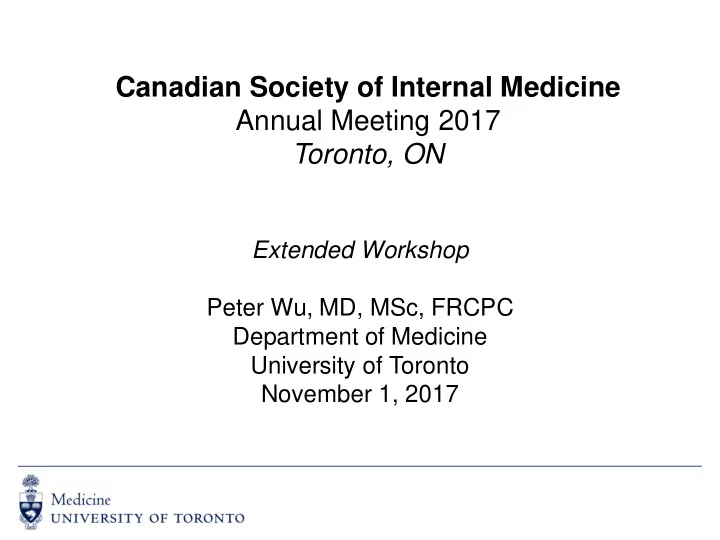

Canadian Society of Internal Medicine Annual Meeting 2017 Toronto, ON Extended Workshop Peter Wu, MD, MSc, FRCPC Department of Medicine University of Toronto November 1, 2017
CSIM Annual Meeting 2017 The following presentation represents the views of the speaker at the time of the presentation. This information is meant for educational purposes, and should not replace other sources of information or your medical judgment.
CSIM Annual Meeting 2017 Conflict Disclosures “I have no conflicts to declare”
How to think critically about QI projects
Learning Objectives • Establish an approach to appraising quality improvement studies
Learning Objectives • Establish an approach to appraising quality improvement studies • Focus on the how
Learning Objectives • Establish an approach to appraising quality improvement studies • Focus on the how • Apply to your own projects
GENERAL STRUCTURE • Introduction – Problem and Aim • Methods • Results • Conclusion
“Focus more on the blueprint of success, rather than the success itself” -Kaveh Shojania
GENERAL STRUCTURE • Introduction – Problem and Aim • Methods • Results • Conclusion
How? • Define and measure the problem • Characterize the problem • Develop the intervention • Deploy the intervention
PDSA as a tool
PDSA Tomolo AM et al. Postgrad Med J 2009;85:530–7
PDSA • Less than half of studies meet minimum requirements for PDSA • Less than 20% fully document iterative cycles • Only 15% report data-driven change at at monthly or more frequent intervals
How? • Define and measure the problem • Characterize the problem • Develop the intervention • Deploy the intervention
Defining and measuring the problem
• Benzodiazepine use at 6 months
Defining and measuring the problem • Not always so easy
Defining and measuring the problem • Not always so easy • Incident reports
• Not incident reports alone • Active surveillance • Intensive
Defining and measuring the problem • Can you clearly articulate your problem? • Can you measure it? Accurately, easily?
How? • Define and measure the problem • Characterize the problem • Develop the intervention • Deploy the intervention
Characterizing the problem • Not only what, but why • Diagnostic work • Leads to intervention
Developing the intervention • Not always a “light-switch” • Multifaceted • Should be revised and revisited
Interventions • Too Soon • No theory (“Magical Thinking”) • Too good to be true • Active ingredient(s)
• Many patients had catheters without indication • Inserted in ED • Often triggered by order set
• Many patients had catheters without indication • Inserted in ED • Often triggered by order set • Nurses communicate • Some even prompt to discontinue
• Many patients had catheters without indication • Inserted in ED • Often triggered by order set • Nurses communicate • Some even prompt to discontinue
Characterizing the problem • Do you know why it happens? • What are the “root-cause(s)”? • Have you done enough diagnostic work?
Developing the intervention • What is the “theory” behind the intervention idea? • How is it linked to your diagnostics? • How might it change?
How? • Define and measure the problem • Characterize the problem • Develop the intervention • Deploy the intervention
Deploying interventions
• Mailing recruitment • Telephone call • In-home interview with study team • Booklet (information, tapering suggestion)
• 2-hour workshop • 1-hour role play and simulation • Faculty development • Direct observation • Branding
Deploying interventions
Deploying interventions
Deploying interventions We hope that these findings from Ontario will lead to greater attention not just to the intervention but also to the implementation process.
Deploying interventions • Characterized where protocol failed and tailored intervention • Increased protocol adherence from 51.3% to 85.7% • Reduced surgical site infection rates
Deploying the intervention • Is the intervention highly adoptable? • Is it sustainable? • (Were people engaged appropriately?)
GENERAL STRUCTURE • Introduction – Problem and Aim • Methods • Results • Conclusion
Did the change result in improvement? Jobson M et al. Pediatrics 2015;135:e187-95
Did the change result in improvement? • Compared to controls, intervention not associated with reduction in ED LOS • Multiple simultaneous interventions
Did the change result in an improvement? • How will you know? (Ability to measure) • Controls
Objectives • How to think critically about QI projects
Objectives • Focus on the how • Problem, Diagnostics, Development/Deployment • Did it work?
Objectives • Focus on the how • Problem, Diagnostics, Development/Deployment • Did it work? • Adoptable?
Thank you
Recommend
More recommend